SUSPECT TRANSTHYRETIN AMYLOID CARDIOMYOPATHY
懷疑是運甲狀腺素
clues to make a diagnosis.1-3
HIDDEN IN PLAIN SIGHT
藏在眼前的疾病
SUSPECT
懷疑可能是
The diagnosis of

CONSIDER THE FOLLOWING CLINICAL CLUES, ESPECIALLY IN COMBINATION, TO RAISE SUSPICION FOR

正常收縮分率心衰竭 (HFpEF) 患者,通常為 60 歲以上4
- In
ATTR-CM , diastolic function is impaired due to amyloid fibril deposition in the myocardium, resulting in thicker and inelastic ventricles, thereby decreasing stroke volume. It is not until the later stages ofATTR-CM disease that ejection fraction drops8,9 - Prevalence among older HFpEF patients:
- ~10% of patients referred to a dedicated center had
ATTR-CM confirmed by EMB10† - ~13% of hospitalized patients with HFpEF and increased LV wall thickness had
wtATTR-CM confirmed by scintigraphy5‡
- ~10% of patients referred to a dedicated center had
- In patients undergoing transcatheter aortic valve replacement for severe calcific AS, prevalence of
ATTR-CM was 16% overall and 22% among men6
Reduced longitudinal strain with apical sparing should raise suspicion of
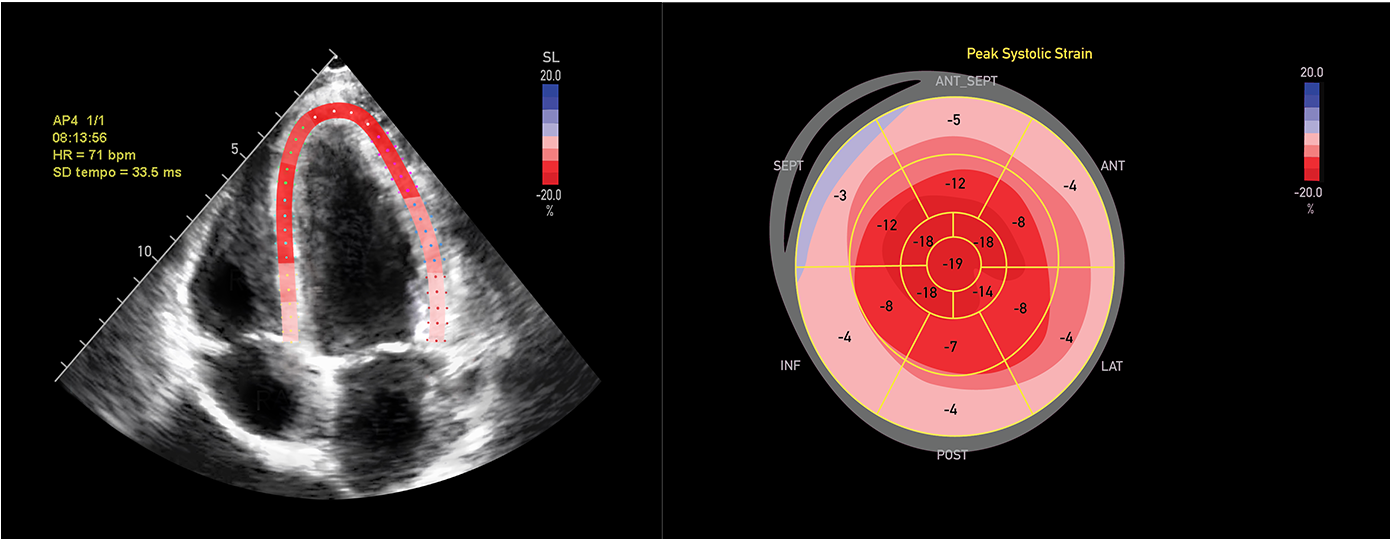
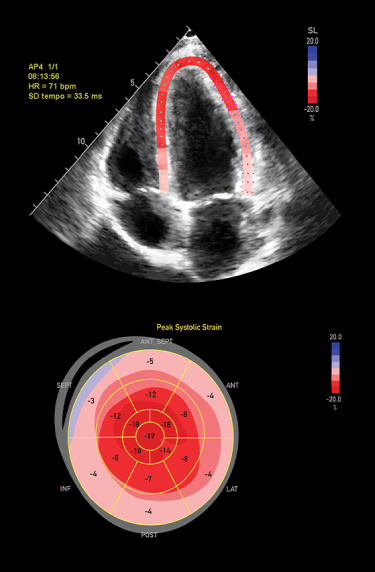
Illustrative representation.

無法耐受標準心衰竭藥物治療 (如:ACEi、ARBs、
- Intolerance to standard heart failure medications is common in patients with cardiac amyloidosis; such agents exacerbate symptomatic hypotension in the setting of concomitant autonomic dysfunction or by lowering heart rate and reducing cardiac output11

心電圖的 QRS 電位與心臟超音波影像的左心室壁厚度呈現矛盾的結果10,11
- The classic ECG feature of
ATTR-CM is a discordance between QRS voltage and LV mass ratio7 - The amplitude of the QRS voltage is not reflective of the increased LV wall thickness, because the increase is due to extracellular amyloid protein deposition rather than myocyte hypertrophy1
- Absence of a low QRS voltage does not, however, rule out amyloidosis, as low voltage can vary among cardiac amyloidosis etiologies12,14-17
Discordance between LV wall thickness and QRS voltage

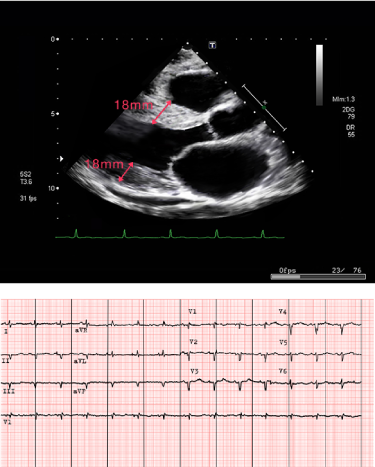
Illustrative representation.

診斷出腕隧道症候群或腰椎管狹窄症12,13
Bilateral carpal tunnel syndrome and lumbar stenosis
- Often seen in
ATTR-CM due to amyloid deposition in these areas; lumbar spinal stenosis is principally seen inwtATTR-CM 7,18,19 - Bilateral carpal tunnel syndrome and lumbar spinal stenosis are known clinical predictors of
ATTR-CM and may precede heart failure symptoms by several years7,19 - Among patients undergoing carpal tunnel release surgery, 10.2% had amyloid deposits22
Biceps tendon rupture
- Among patients with
wtATTR-CM , biceps tendon rupture has been observed in 33% of patients, occurring in the dominant arm in 95% and bilaterally in 24% of patients20
Hip and knee arthroplasty
- In a study of 313 patients (172 with
ATTR-CM ), hip and knee arthroplasty surgeries were more frequent than in the general population, and on average, arthroplasty occurred 7.2 years beforeATTR-CM diagnosis21

心臟超音波結果顯示左心室壁增厚10
- Unexplained increased LV wall thickness (eg, hypertension) should raise suspicion for cardiac amyloidosis3
Transthoracic echocardiograms showing increased LV wall thickness
Parasternal long-axis view
Parasternal short-axis view
ATTR amyloidosis heart
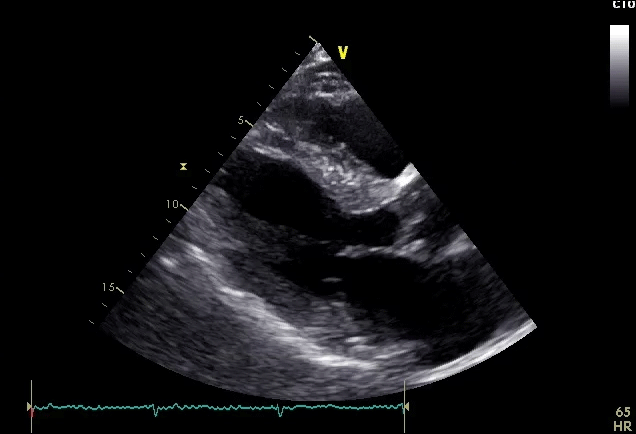
Video courtesy of Filiale d'Imagerie Cardiovasculaire.
ATTR amyloidosis heart
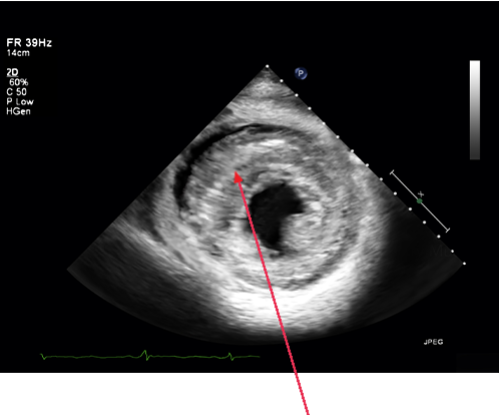
Increased LV end diastolic interventricular wall thickness
Normal heart
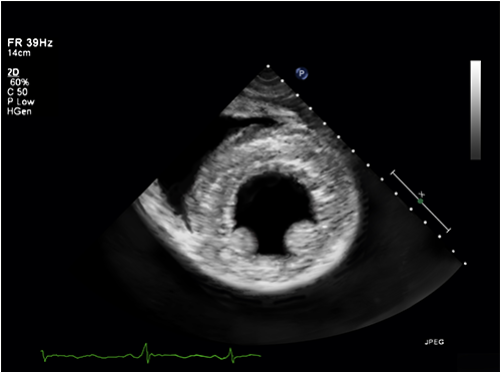
Illustrative representation.

自主神經系統功能異常,包括腸胃道不適或無法解釋的體重減輕14
- Gastrointestinal complaints due to autonomic dysfunction include chronic diarrhea, constipation, or both23
- Orthostatic hypotension due to autonomic dysfunction is another symptom that may occur with
ATTR-CM 23

USE THE estimATTR TO LEARN ABOUT CLINICAL CONDITIONS COMMONLY ASSOCIATED WITH
利用 estimATTR,了解
A PROBABILITY ESTIMATOR FOR
This tool is only to be used by Taiwan health care professionals. It is for educational purposes only, and is not to be used for the suspicion or diagnosis of
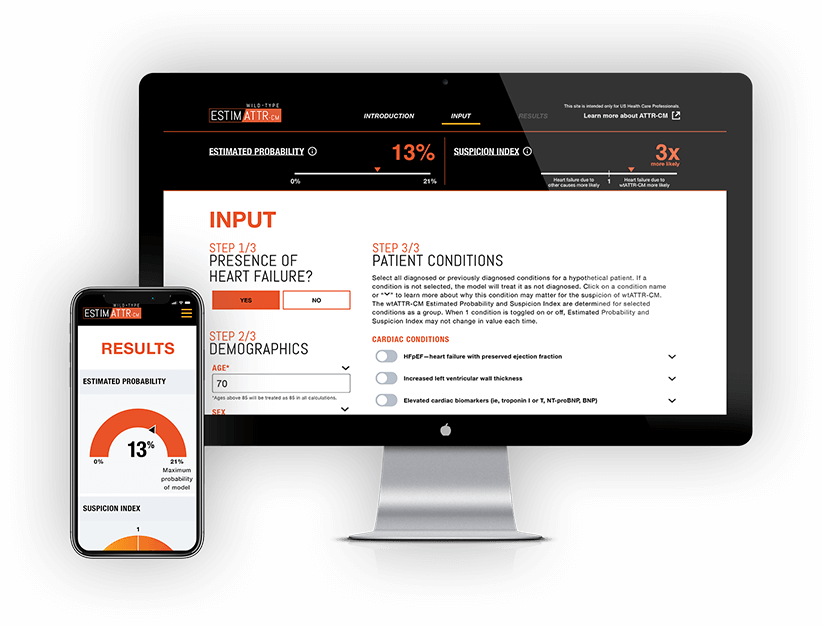
The
Using hypothetical patient cases presenting with heart failure, the estimATTR can highlight the types of combinations of cardiac and noncardiac conditions that should raise suspicion for
- Estimating the probability of
wtATTR-CM based on combinations of clinical features known to be associated with the disease - Illustrating important features that help distinguish between
wtATTR-CM and heart failure from other causes
THE HIDDEN CLINICAL CLUES OF ATTR-CM
Discover how a cardiologist suspects
In the first video, a colleague asked Dr. Detective for help with a tough case. Watch to see how looking for certain signs and symptoms can point to
References: 1. Narotsky DL, Castaño A, Weinsaft JW, Bokhari S, Maurer MS. Wild-type transthyretin cardiac amyloidosis: novel insights from advanced imaging. Can J Cardiol. 2016;32(9):1166.e1-1166.e10. 2. AlJaroudi WA, Desai MY, Tang WH, Phelan D, Cerqueira MD, Jaber WA. Role of imaging in the diagnosis and management of patients with cardiac amyloidosis: state of the art review and focus on emerging nuclear techniques. J Nucl Cardiol. 2014;21(2):271-283. 3. Rapezzi C, Lorenzini M, Longhi S, et al. Cardiac amyloidosis: the great pretender. Heart Fail Rev. 2015;20(2):117-124. 4. Brunjes DL, Castano A, Clemons A, Rubin J, Maurer MS. Transthyretin cardiac amyloidosis in older Americans. J Card Fail. 2016;22(12):996-1003. 5. González-López E, Gallego-Delgado M, Guzzo-Merello G, et al. Wild-type transthyretin amyloidosis as a cause of heart failure with preserved ejection fraction. Eur Heart J. 2015;36(38):2585-2594. 6. Castaño A, Narotsky D, Hamid N, et al. Unveiling transthyretin cardiac amyloidosis and its predictors among elderly patients with severe aortic stenosis undergoing transcatheter aortic valve replacement. Eur Heart J. 2017;38(38):2879-2887. 7. Ruberg FL, Grogan M, Hanna M, Kelly JW, Maurer MS. Transthyretin amyloid cardiomyopathy: JACC state-of-the-art review. J Am Coll Cardiol. 2019;73(22):2872-2891. 8. Borlaug BA, Paulus WJ. Heart failure with preserved ejection fraction: pathophysiology, diagnosis, and treatment. Eur Heart J. 2011;2(6):670-679. 9. Siddiqi OK, Ruberg FL. Cardiac amyloidosis: an update on pathophysiology, diagnosis, and treatment. Trends Cardiovasc Med. 2018;28(1):10-21. 10. Hahn VS, Yanek LR, Vaishnav J, et al. Endomyocardial biopsy characterization of heart failure with preserved ejection fraction and prevalence of cardiac amyloidosis. JACC Heart Fail. 2020;8(9):712-724. doi:10.1016/j.jchf.2020.04.007 11. Castaño A, Drachman BM, Judge D, Maurer MS. Natural history and therapy of TTR-cardiac amyloidosis: emerging disease-modifying therapies from organ transplantation to stabilizer and silencer drugs. Heart Fail Rev. 2015;20(2):163-178. 12. Quarta CC, Solomon SD, Uraizee I, et al. Left ventricular structure and function in transthyretin-related versus light-chain cardiac amyloidosis. Circulation. 2014;129(18):1840-1849. 13. Carroll JD, Gaasch WH, McAdam KP. Amyloid cardiomyopathy: characterization by a distinctive voltage/mass relation. Am J Cardiol. 1982;49:9-13. 14. Maurer MS, Hanna M, Grogan M, et al. Genotype and phenotype of transthyretin cardiac amyloidosis: THAOS (Transthyretin Amyloid Outcome Survey). J Am Coll Cardiol. 2016;68(2):161-172. 15. Connors LH, Sam F, Skinner M, et al. Heart failure resulting from age-related cardiac amyloid disease associated with wild-type transthyretin: a prospective, observational cohort study. Circulation. 2016;133(3):282-290. 16. Cyrille NB, Goldsmith J, Alvarez J, Maurer MS. Prevalence and prognostic significance of low QRS voltage among the three main types of cardiac amyloidosis. Am J Cardiol. 2014;114(7):1089-1093. 17. Ng B, Connors LH, Davidoff R, Skinner M, Falk RH. Senile systemic amyloidosis presenting with heart failure: a comparison with light chain-associated amyloidosis. Arch Intern Med. 2005;165(12):1425-1429. 18. Nakagawa M, Sekijima Y, Yazaki M, et al. Carpal tunnel syndrome: a common initial symptom of systemic wild-type ATTR (ATTRwt) amyloidosis. Amyloid. 2016;23(1):58-63. 19. Westermark P, Westermark GT, Suhr OB, Berg S. Transthyretin-derived amyloidosis: probably a common cause of lumbar spinal stenosis. Ups J Med Sci. 2014;119(3):223-228. 20. Geller HI, Singh A, Alexander KM, et al. Association between ruptured distal biceps tendon and wild-type transthyretin cardiac amyloidosis. JAMA. 2017;318(10):962-963. 21. Rubin J, Alvarez J, Teruya S, et al. Hip and knee arthroplasty are common among patients with transthyretin cardiac amyloidosis, occurring years before cardiac amyloid diagnosis: can we identify affected patients earlier? Amyloid. 2017;24(4):226-230. doi:10.1080/13506129.2017.1375908 22. Sperry BW, Reyes BA, Ikram A, et al. Tenosynovial and cardiac amyloidosis in patients undergoing carpal tunnel release. J Am Coll Cardiol. 2018;72(17):2040-2050. 23. Coelho T, Maurer MS, Suhr OB. THAOS - The Transthyretin Amyloidosis Outcomes Survey: initial report on clinical manifestations in patients with hereditary and wild-type transthyretin amyloidosis. Curr Med Res Opin. 2013;29(1):63-76.
